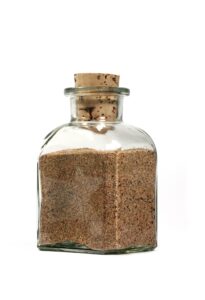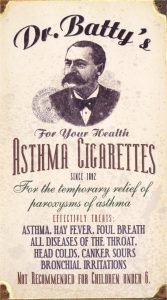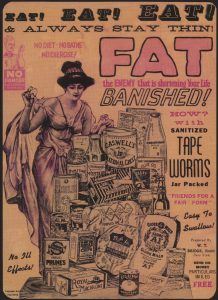 McALISTER’S
McALISTER’S
ALL-HEALING OINTMENT
OR WORLDS SALVE
Has been an old family nurse for the past twenty years, and known all around the world as the most soothing and healing ointment in existence.
McALISTER’S ALL-HEALING OINTMENT
Never Fails to Cure.
Salt Rheum, Scrofula, Ulcers, Small Pox, Sore Nipples, Mercurial Sores, Erysipelas, Carbuncles, Corns, Bunions, and all Rheumatic Pains, &c. &c. Heals permanently Old Sores and Fresh Wounds. For Frosted Limbs, Burns, or Scalds. It has no equal in the World. Give it a trial.
Price 25 cents. Sold by all Druggists.
.
Source: Bangor Daily Whig and Courier (Maine) 6 March 1867
.
——————————————————
.
The aura surrounding the figure in this ad is not just for decoration. It represents insensible perspiration (sweat that evaporates before it can build up as moisture on the skin.) James McAlister believed insensible perspiration arose from the blood and drew off all impurities therein. Illness suppressed it, and life could not be sustained without it. ‘Stop up those pores,’ he said, ‘and DEATH knocks at your door.’
The All-Healing Ointment, or World’s Salve, would promote perspiration and restore health – but that wasn’t all. As well as the list of conditions in the ad, it would cure consumption, cancer, worms, influenza, hernias and dog bites. It was an antidote to poison, would correct a tan or freckles and was even a hair restorer. Using a topical application made sense, McAlister argued, because throughout the Bible, medicine took the form of ointments and oils rather than being taken internally.
Here’s a male version of the image from the nostrum’s early days (1845):

The figure above is in rude health, with his insensible perspiration flowing freely around him – he is far more fortunate than the gentleman featured in an 1847 broadside. According to the text, the man had come to McAlister’s shop in South Street, New York City, in despair.

Few men ever presented an appearance as appalling as his. His whole body from head to foot was covered with enormous
Tumors, Swellings and Ulcerous Sores,
from whence issued streams of purulent matter, making the entire surface
ONE MASS OF PUTREFACTION.
It seemed that nothing to be found had power to reach his case,
SO TERRIBLE! SO AWFUL! WERE THESE PUTRID SORES
He came into the store, and presented himself as one of the most pitiable objects, one of the most forlorn in expression of countenance of any man, I think, I had ever seen. The first words he uttered I shall never forget, coming as they did from the depths of the poor fellows heart,
“Oh! that I was dead!”
The melodrama continues, with the customer stripping off to reveal the extent of the putrefaction and detailing the failure of various sarsaparilla syrups, mercury and other medicines to help him. McAlister tells him the All-Healing Salve will save him; at this,
His whole frame shook like a leaf—his eyes shot forth unwonted fire, and every feature of his countenance was lit up with an unearthly expression.—Hope! Yes, Immortal hope, the last friend that forsakes us, dawned upon his soul, and he caught at the facts presented to him with the desperation of a drowning man.
After eight weeks’ use of the ointment, the man returns to the shop, smooth-skinned and exhibiting the greatest signs of health and happiness.
In April 1856 McAlister entered into an agreement with wholesale druggists Barnes & Park to supply them exclusively with the salve. Five years later, however, Barnes & Park realised that McAlister had been selling large quantities of the ointment to rival druggists, including A. D. Sands, (who also promoted sarsaparilla products like those that failed to cure our scrofulous friend above.) Barnes & Park sought an injunction restraining McAlister from selling the ointment to anyone else, but details of the case show that it wasn’t a clear-cut instance of an unscrupulous quack breaking his contract.
Barnes & Park had agreed to promote the salve but had not really bothered, and sales had diminished. In 1858 the company became sole agents for Redding & Co’s Russian Salve, which was effectively a rival to the All-Healing Ointment. If he had kept to the agreement, McAlister could have seen his product sink without trace. Justice Bonney, who oversaw the hearing, decided that both sides were as bad as each other, and dismissed the case with costs.

McAlister kept the ingredients a secret, but sometimes referred to the salve as ‘Vegetable’ (as in the print above), and claimed it ‘contains no Mercury’. I don’t know whether or not he was telling the truth, but I do know that in the language of 19th-century nostrum-vendors, these were common indicators that mercury was indeed present.



Fascinating story, which must have taken quite a lot of detective work.
I see that sarsaparilla is still being sold for extraordinary properties:
http://www.aquarterof.co.uk/sarsaparilla-tablets-p-116.html
I must also congratulate you on the design of your new website. It is eye-catching, and effective.
Thanks Michael – glad you like the post and the site design. I’ve really enjoyed putting the new site together after the limitations of the old wordpress.com blog.
I have seen sarsaparilla drinks before but didn’t know there were sweets too!
Yes yes, the poor mans whole person was covered in pulsating pustules of putrefying puss. It’s no wonder he was so pleased and panegyric when he found the prodigy that was McAlister’s All Healing Ointment.
Pleasingly poetic and astoundingly alliterative comment, Will – thanks!